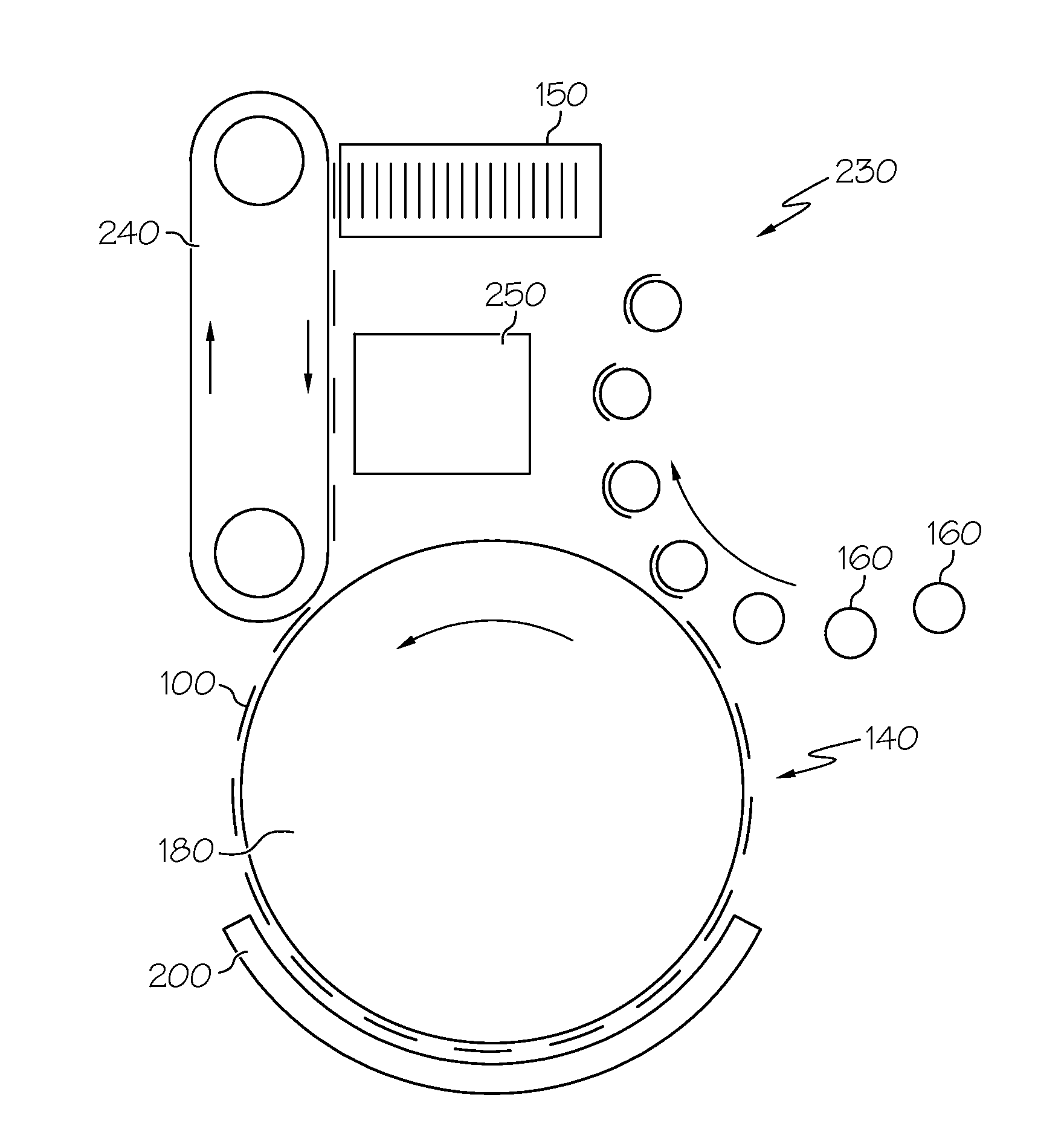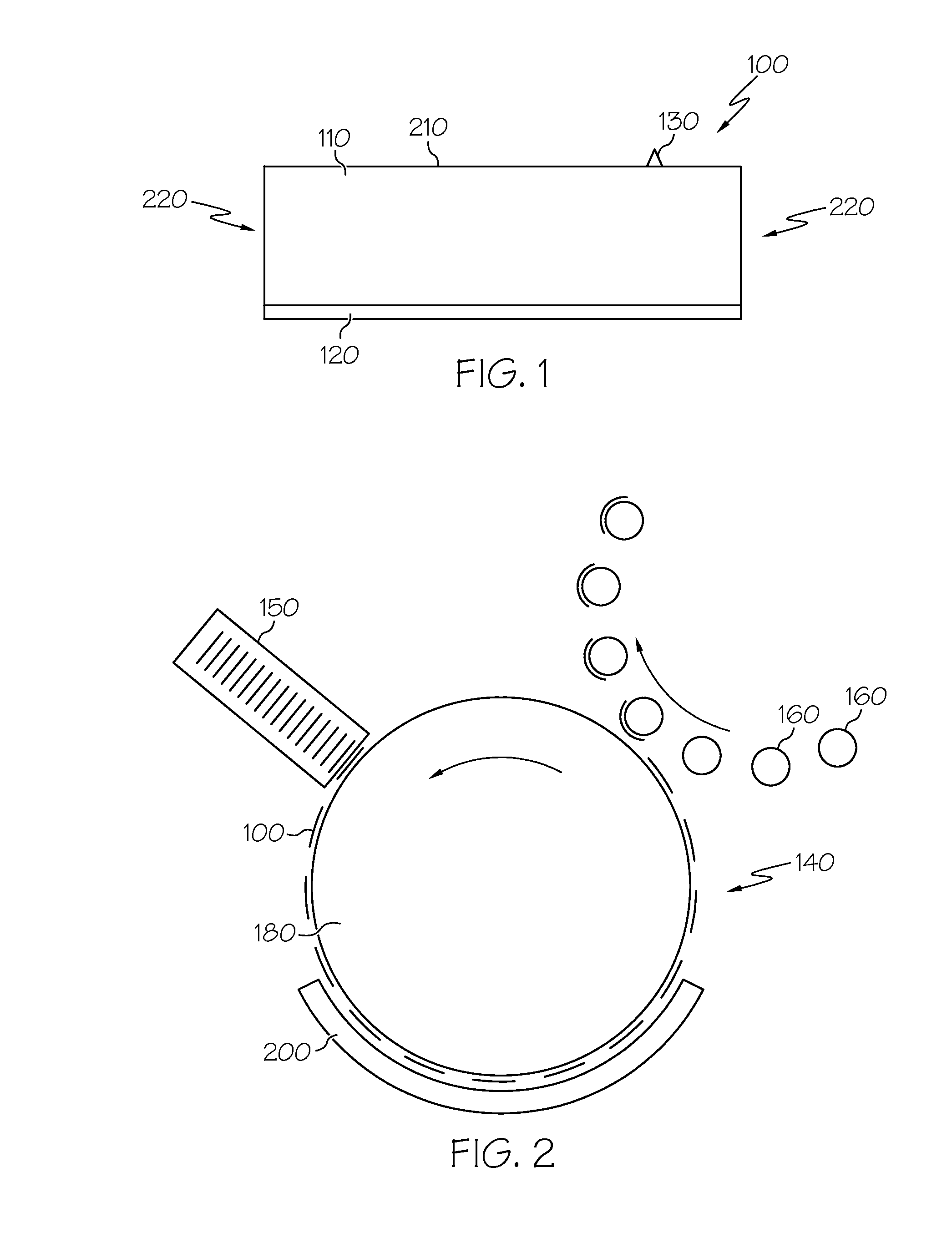Activatable Adhesive, Labels, and Related Methods
a technology of activated adhesives and labels, applied in the field of activated adhesives and label activation, can solve the problems of not being able to be used as sources of recycled paper, adhesive buildup still occurs in various sections of equipment, and linerless labels have not received wide customer acceptance, so as to improve the safety and operability of the system
- Summary
- Abstract
- Description
- Claims
- Application Information
AI Technical Summary
Benefits of technology
Problems solved by technology
Method used
Image
Examples
example 1
[0148]An emulsion adhesive polymer base is prepared by emulsion polymerization from a plurality of monomers consisting of 37.2% butyl acrylate (BA), 29.3% styrene, 29.3% methyl methacrylate (MMA), 1.7% methacrylic acid (MAA), and 2.5% acrylic acid (AA), based on the weight of all monomers, with 0.06% by weight of n-dodecy mercaptan added as a chain transfer agent. A one-liter, jacketed, cylindrical reaction flask equipped with a four-neck flask head was fitted with a steel stirring rod with multiple steel blades, a reflux condenser, a thermometer, and a nitrogen inlet tube. The stirring speed is set at approximately 126 rpm, and the reaction temperature was set at 80° C. A reactor pre-charged solution is made by dissolving 1.0 g of HITENOL BC-10 (97% solids, manufactured by Dai-lchi Kogyo Seiyaku Co., Ltd. of Kyoto, Japan) surfactant in 100 g deionized (“DI”) water. A pre-emulsion feed soap solution is formed by dissolving 2.0 g HITENOL BC-10 and 105 g DI water. A monomer mix is made u
example 2
[0149]The same polymerization procedure that is used in Example 1 is used, except that the monomers used for the polymerization are used in the following weight percentages. 48.0% BA, 23.9% styrene, 23.9% MMA, 1.7% MAA, and 2.5% AA.
[0150]Preparation of an exemplary white heat-activated adhesive is as follows. A switchable adhesive formulation is prepared from the noted adhesive polymer base by blending with a selected plasticizer and tackifier at room temperature for enough time to ensure a homogenous composition. Typically, the preferred melting point of such solid plasticizer is above 40° C. In this example, ground plasticizer dicyclohexyl phthalate or U250M supplied by Unitex Corp. of Greensboro, N.C. is used. The melting point of U250M is in the range of 63° C. to 65° C. The exemplary tackifier is TACOLYN 3400 (softening point 92° C.) which is a resin dispersion by Eastman Chemical Company of Kingsport, Tenn. TACOLYN 3400 is a resin ester dispersion. More specifically, TACOLYN 3400
example 3
[0151]An acrylic emulsion based polymer particularly adapted for linerless heat-activatable adhesives was prepared as follows. Referring to Table 4 below, a reactor charge is made by dissolving 18.2 g HITENOL BC-10 surfactant (97% solids), 18.2 g POLYSTEP B-19 surfactant available from Stepan of Northfield, Ill. (sodium lauryl ether sulfate, 32.5% solids), and 1.1 g DREWPLUS L-198 foam control agent available from Ashland Aqualon of Ashland, Inc. of Lexington, Ky., in 19.376 kg of deionized (“DI”) water. This is summarized as reactor charge (A) in Table 4. As described later herein, 90.8 g of potassium persulfate (“K-persulfate”) is subsequently added to this charge prior to pre-emulsion feed.
TABLE 4Exemplary Reactor ChargeParts by WeightgLbsA)Reactor Charge:Di-water19,37642.718POLYSTEP B-19 (32.50%)18.200.04HITENOL BC-10 (97.0%)18.200.04DREWPLUS L-198 (100.0%)1.100.002Kick-off K-persulfate90.800.20Total19,504.3043.00B)Soap Solution:Di-water14,45531.868POLYSTEP B-19 (32.50%)853.521.88A
PUM
| Property | Measurement | Unit |
|---|---|---|
| Temperature | aaaaa | aaaaa |
| Temperature | aaaaa | aaaaa |
| Length | aaaaa | aaaaa |
Abstract
Description
Claims
Application Information
 Login to view more
Login to view more - R&D Engineer
- R&D Manager
- IP Professional
- Industry Leading Data Capabilities
- Powerful AI technology
- Patent DNA Extraction
Browse by: Latest US Patents, China's latest patents, Technical Efficacy Thesaurus, Application Domain, Technology Topic.
© 2024 PatSnap. All rights reserved.Legal|Privacy policy|Modern Slavery Act Transparency Statement|Sitemap



